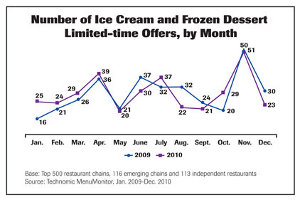
|
Therefore, it might be easy to assume that restaurants would promote frozen treats during the spring or summer months. However, Technomic’s menu-tracking database, MenuMonitor, found that is not the case. Fall was the most popular time for ice cream and frozen dessert, limited-time offers (LTOs)—specifically, November.
LTOs spiked in that month in both 2009 and 2010, with 50 and 51 offerings, respectively. Chains that promoted LTOs in November included Baskin-Robbins, which introduced a new ice cream Flavor of the Month: Gingerbread Man; Denny’s, which rolled out three new peppermint-infused milkshakes; and Krystal Company, which added the Holiday Egg Nog Milkquake. The examples suggest November LTOs often incorporate seasonal flavors typically associated with winter (in general) and Christmas (in particular).
April was the second-most popular LTO month, with 39 LTOs in 2010 and 36 LTOs in 2009. Examples, such as Carrows Restaurants’ Fresh Strawberry Hot Fudge Sundae, Chick-fil-A’s Peach Milkshake and Friendly’s Raspberry Mango Swirl Sorbet, indicate many restaurants view April as the ideal month for launching frozen treats made with fresh, seasonal fruits.
Surprisingly, May is not a popular month for frozen dessert LTOs. In 2010, May tied with September for having the fewest LTOs (21 items). This is interesting, since one might expect chains to heavily promote frozen desserts just prior to the official start of summer, when warm weather fuels purchases of cold treats. February also had some of the fewest LTOs of any month (just 24 in 2010 and a mere 21 in 2009).
Operators should consider this data, when deciding when to introduce a new ice cream flavor or bring back a favorite sundae. There might be an opportunity to promote LTOs during months such as May and February, when there have historically been fewer new-item rollouts.
So what kind of frozen desserts should restaurants consider rolling out? Technomic’s consumer data suggests mini-desserts are a smart way to go. Technomic’s “2010 Dessert Consumer Trend Report” revealed two out of five consumers say they strongly prefer the option of ordering mini-desserts at a reduced price (40%) or half-portion desserts (37%) at a restaurant. From a consumer standpoint, minis are attractive for their lower prices and smaller portion size, which appeals to health-conscious consumers. They are also an easy way to try new or more “out there” flavors they otherwise might not. From an operator standpoint, minis represent a low-cost, low-risk way to demonstrate menu innovation, test new items and differentiate their concepts.
Ahead of the Health Curve
Barbara Nessinger, Associate Editor
The FDA’s proposed menu labeling law, requiring chain restaurants to disclose calorie counts on menus and provide other nutritional information, goes into effect late next year. And, the National Restaurant Association’s attitude is, essentially, “Bring it on.” An April 2, 2011, Wall Street Journal article cited some of the reasons.
The NRA has said chains do not mind revealing this information, as long as there are nationwide, standard regulations and a reasonable implementation period. Many chains have already been providing this information. Others, which have highlighted healthy choices on their menus for years, will finally be recognized as being ahead of the curve.
“I think the new regulations will be good for us, because we will finally get some credit for all the things we’ve been doing with our healthy menu options,” states DineEquity’s chief executive, Julia Stewart.
Another plus, from a restaurateur’s perspective, is continually rising beef prices and a drop in frozen turkey prices. As the Journal reports, “The latest salvo in the move to healthier options comes in the form of turkey burgers from Hardee’s and Carl’s Jr., both owned by CKE Restaurants. The chains are switching from touting 1,000-calorie-plus burgers to just under 500-calorie turkey burgers.” Moves such as this could be considered just in time, as calorie counts become more prominent on menus and in consumers’ minds.
There is some doubt, however, about the new regulation’s effect on consumer spending. An NDP study, conducted on the effects of adding calorie counts to menus, said on average, consumers spent 20 cents less on their meals, when ordering off a calories-displayed menu. However, chains can minimize this somewhat negative factor by adding healthier side items, said NPD Group restaurant analyst, Bonnie Riggs. pf
